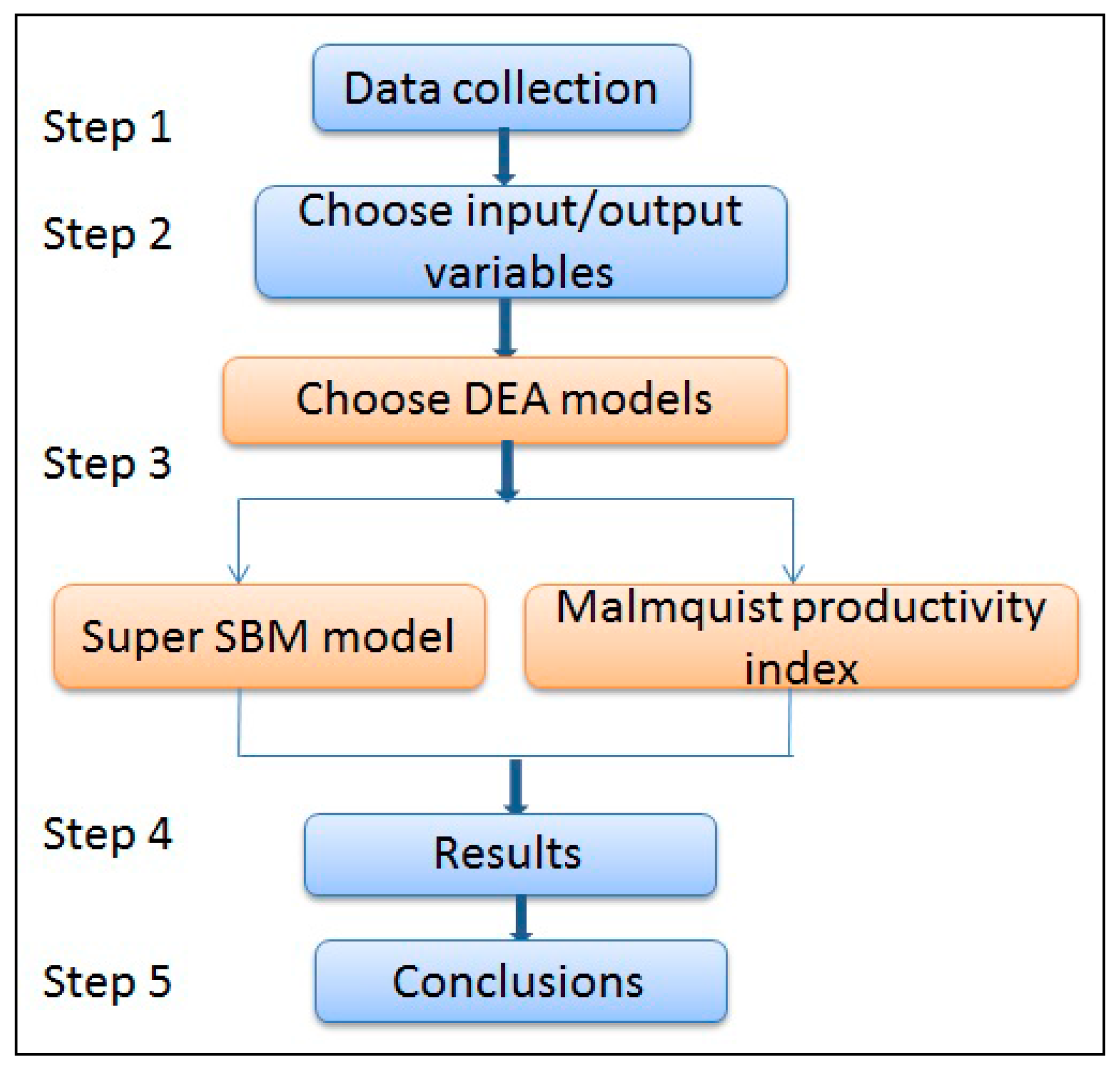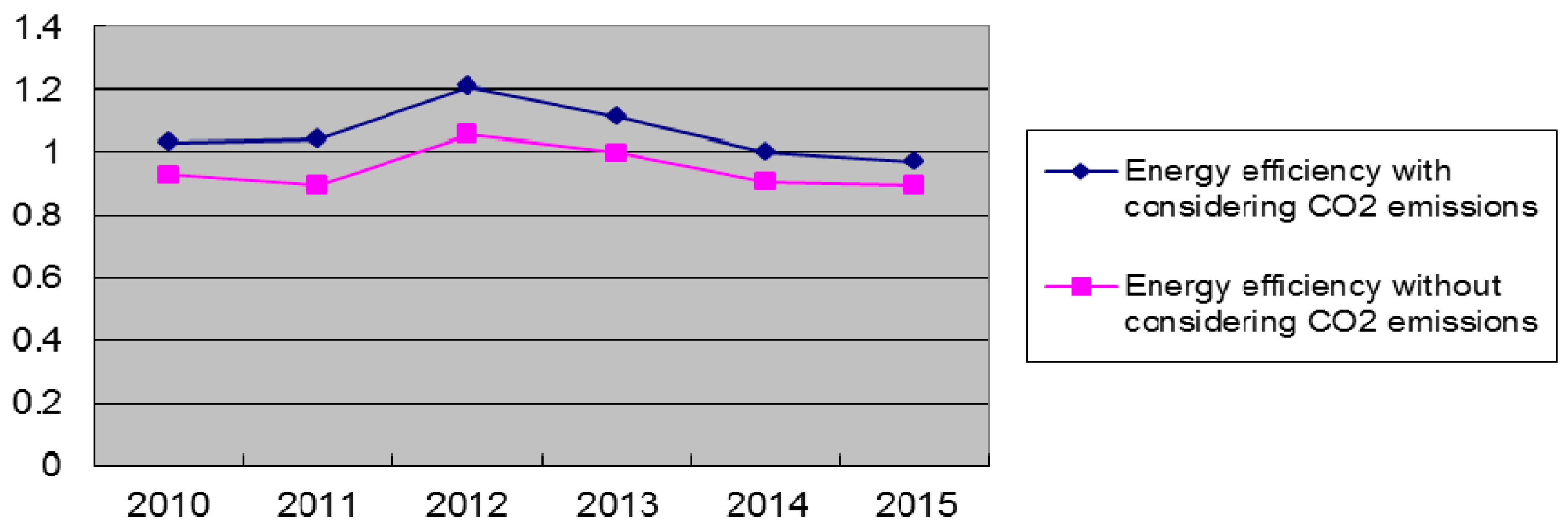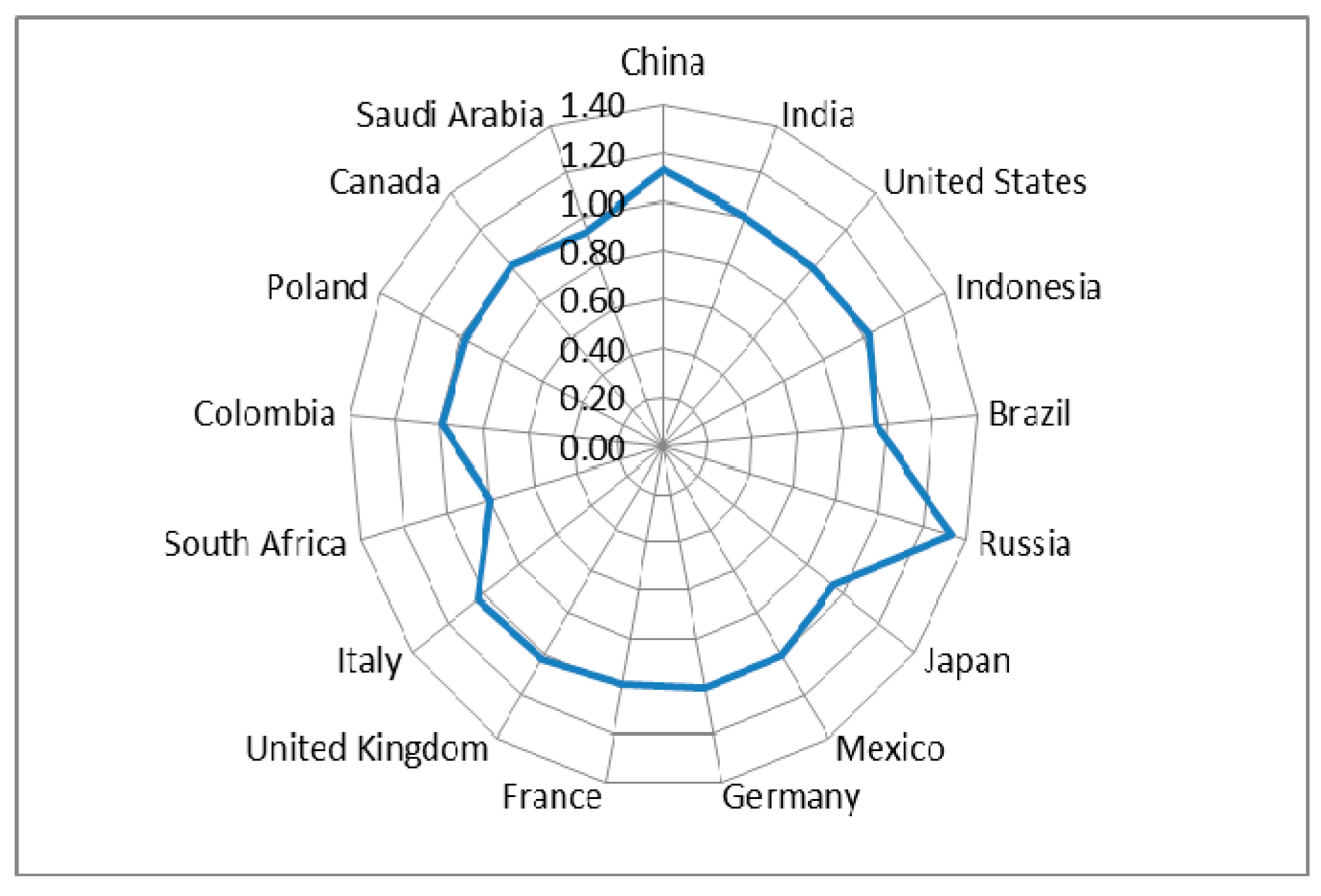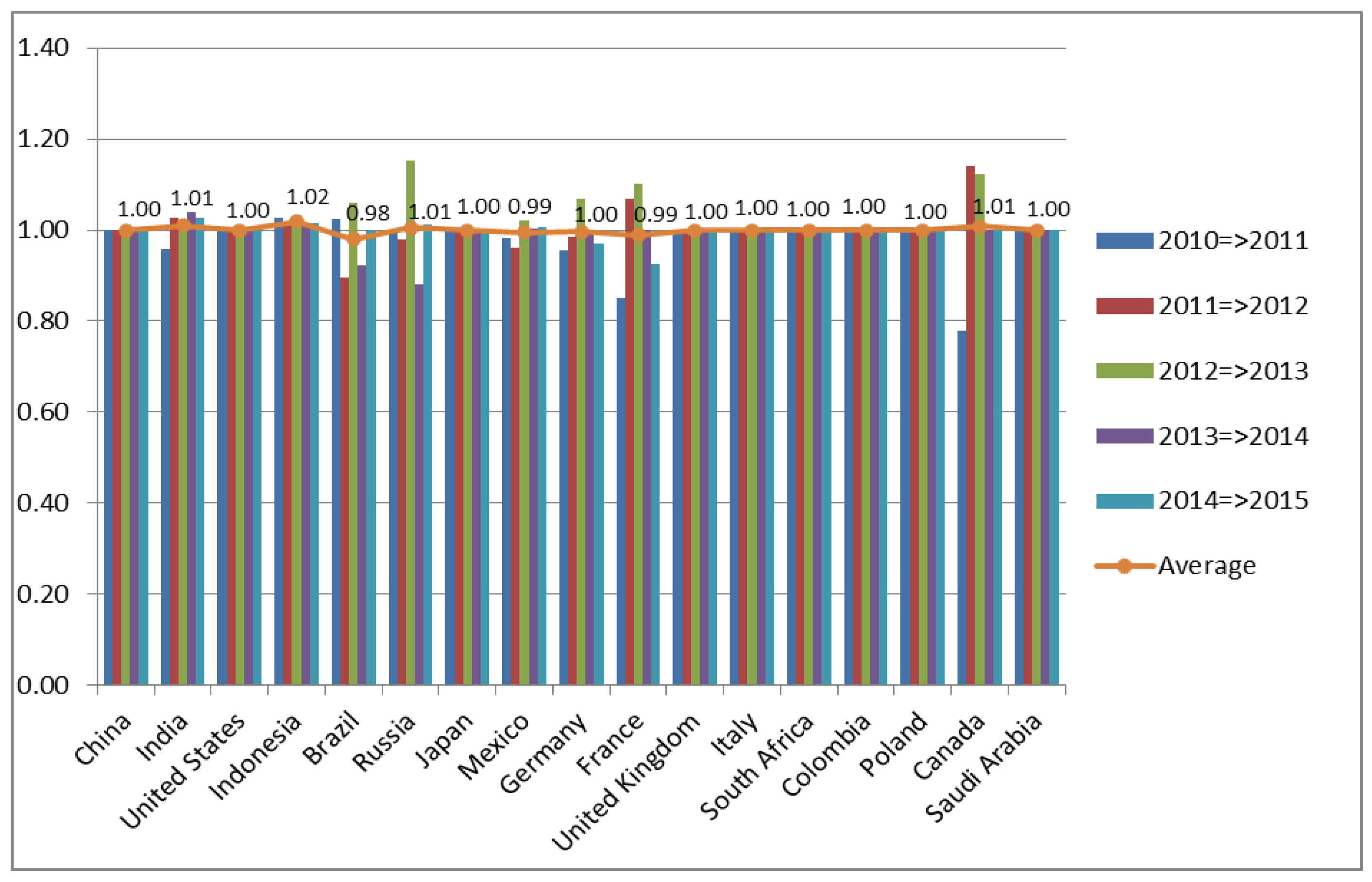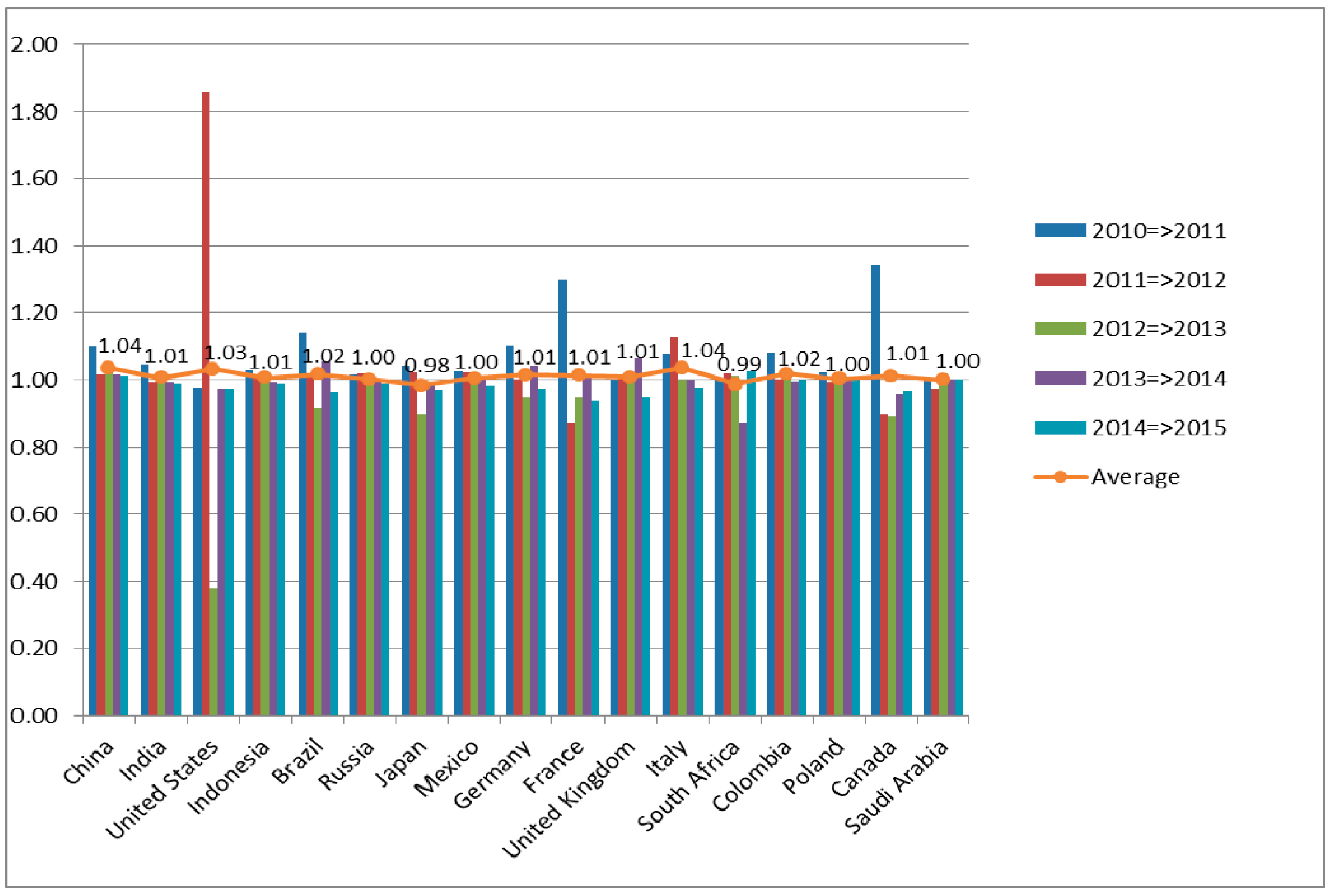Energy consumption and greenhouse gases are directly related to global warming and climate change. At present, due to the world’s considerable economic growth, energy production is considered to have a key role in the economic development of many countries. However, energy production growth has led some nations to expend more costs with environmental pollution. Between the 1990s and 2005, the International Energy Agency estimated that global final energy use increased by 23%, while the associated carbon dioxide (CO
2) emissions rose by 25% [
1]. Moreover, according to the U.S. Energy Information Administration, world energy consumption will increase by as much as 48% between 2012 and 2040. It contributes to almost 26% of global greenhouse gas emissions [
2]. Thus, to slow down energy consumption and to promote low-carbon output development, improving energy efficiency becomes one of the most effective choices. Nowadays, in order to obtain a strategy of environmental protection and economic growth, many countries’ governments have been implementing a package of policies to improve the energy efficiency. Ang [
3] mentioned that energy efficiency performance can provide useful information for evaluating the effectiveness of energy efficiency polices. Furthermore, the measurement of the energy efficiency with the consideration of environmental factors can help to reduce energy consumption and mitigate environmental pollution [
4].
Therefore, it would be interesting to examine the energy efficiency mode of more countries where energy consumption efficiency is of the greatest concern.
In the context of energy efficiency estimation, there are numerous different indicators to ascertain energy efficiency according to definitions given in literature reviews [
4,
5,
6]. Wang et al. [
7] pointed out that energy efficiency improvements, as well as environmental efficiency, are mainly based on the input factors of energy, capital, labor, and the economic output factor of gross domestic product (GDP). Zhou and Ang [
8] mentioned that input variables involve capital stock, and labor force; and, output variables involve GDP and CO
2 emissions, which are often used to measure energy efficiency. Zhou et al. [
9] showed that total labor force, total primary energy consumption, and capital stock are considered to be inputs; and, GDP and CO
2 emissions are considered as outputs. Lin and Zheng [
10] posed in their work the impact of industrial polices to improve energy efficiency in China’s paper industry. The factors of energy, labor, capital, and gross industrial were all included as input and output factors in their study. Among the studies for G7 countries, Narayan and Smyth [
11] found that capital formation, energy consumption, and real GDP are major factors affecting economic growth and environmental problem. In a study of African countries, Wolde-Rufael [
12] pointed out that real GDP per capita, energy use per capita, gross capital formation per capita, and labor force are important factors of evaluating the causal effect of energy consumption on economic growth.
In the past few years, there is much research that has been done on energy efficiency through various methods. However, in dealing with multiple inputs and outputs used to investigate relative efficiency, data envelopment analysis (DEA) is most commonly used to study energy efficiency [
13,
14,
15]. Some researchers have implemented the DEA approach to measure economic, environmental, and energy efficiency in countries and regions. For instance, Zhang et al. [
6] applied a DEA window to examine the total factor energy efficiency in twenty-three developing countries during the time of 1980–2005. The paper pointed out that Botswana, Mexico, and Panama perform the best in terms of energy efficiency, while Kenya, Philippine, Sri Lanka, and Syria perform the worst in energy efficiency during the sample period. Zhang et al. [
16] employed the Malmquist productivity index (MPI) in order to estimate energy efficiency, CO
2 emissions performance, and technology gaps in fossil fuel electricity generation in Korea. Vlontzos et al. [
17] estimated the energy and environmental efficiency of European countries by implementing DEA models for the period of 2001–2008. Ramanathan [
18] analyzed the energy consumption and carbon dioxide emissions in seventeen countries of the Middle East and North Africa by means of the Malmquist productivity index (MPI) approach. Chen and Jia [
19] applied the DEA based approach to measure the environmental efficiency of China’s regional industry. The results showed that the environmental efficiencies of China’s industry were generally low and did not show any increasing trend through the past five years. Li and Shi [
20] improved the super slack-based model with environmental outputs to perform an energy efficiency analysis on various Chinese industrial sectors. They found that the energy efficiency of each industrial sector had improved substantially during the period from 2001 to 2010. Wu et al. [
21] measured the industrial energy efficiency with CO
2 emissions in China by means of DEA. Egilmez et al. [
22] implemented DEA to analyze the sustainability performance and improve the energy efficiency of the U.S. manufacturing sector. Xue et al. [
23] used DEA to investigate the total energy consumption efficiency of China’s construction industry. Wang et al. [
24] integrated DEA models and grey forecasting methods to evaluate green logistics providers for sustainable development. Chang [
25] applied DEA and directional distance function model to examine the overall efficiency of G7 and BRICS countries, including Canada, France, Germany, Italy, Japan, the United Kingdom, the United States, Brazil, Russia, India, China, and South Africa. The study found out that G7 countries have higher efficiency than BRICS countries before 2005. Energy efficiency is not only about being “environmental friendly”, but it also promotes economic efficiency [
26]. Therefore, it would be interesting to estimate the energy efficiency of one or more countries. Previous studies have shown clearly that there is a relationship between economic growth, energy, and the environment. In addition, energy consumption and CO
2 emissions are factors that have an impact on the environment. As of yet, there has been no study to investigate the energy efficiency of countries, which in list of countries by carbon dioxide emissions including China, India, the United States, Indonesia, Brazil, Russia, Japan, Mexico, Germany, France, the United Kingdom, Italy, South Africa, Colombia, Poland, Canada, and Saudi Arabia by implementing an integration method. As such, this study proposes an effective approach, which combines the super SBM model and the Malmquist productivity index to estimate the energy efficiency of seventeen countries under consideration with and without undesirable factor during the period of 2010–2015. The performance estimation results from these two models may give a comprehensive view of overall energy and environmental productivity efficiency, technical efficiency, and technology efficiency of seventeen countries represented in this study. This research may help policy makers to improve energy efficiency, economic development, as well as to reduce environmental pollution.
